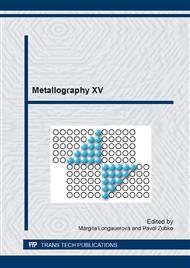p.133
p.137
p.143
p.149
p.155
p.161
p.166
p.172
p.179
Mechanical and Phase Analysis of Bonding Area Explosively Welded Ti-Cr/Ni Steel in as-Received State and after Heat Treatment Using Synchrotron (BW-5)
Abstract:
Surface coatings protection is one of the most important processes ensuring efficient and economic use of basic materials, mostly of lower-quality. At interface of clad and basic material intermetallic phases are formed, representing quite different matrix with dissimilar properties unlike the welded materials. One type of surface coating is explosive bonding which belongs to group of pressure welding. The work is focused on some mechanical properties, micro-and nanohardness controlled by AFM and interface shape line, in homogeneities in vicinity of the wave joint both in basic material and in vicinity of the Ti and Cr/Ni stainless steel matrix weld line. Investigated weld was both in as-received state and after heat treatment carried out at 600°C/90 minutes/air. Phases has been identified X-ray diffraction performed BW-5 beamline applying synchrotron radiation, and Tiα, Fe-fcc and Fe-bcc were detected at interface area, whereas intermetallic phases were not revealed.
Info:
Periodical:
Pages:
155-160
Citation:
Online since:
April 2014
Authors:
Keywords:
Price:
Сopyright:
© 2014 Trans Tech Publications Ltd. All Rights Reserved
Share:
Citation:


